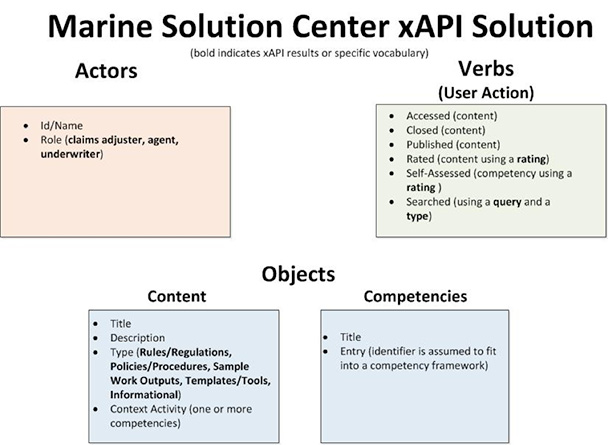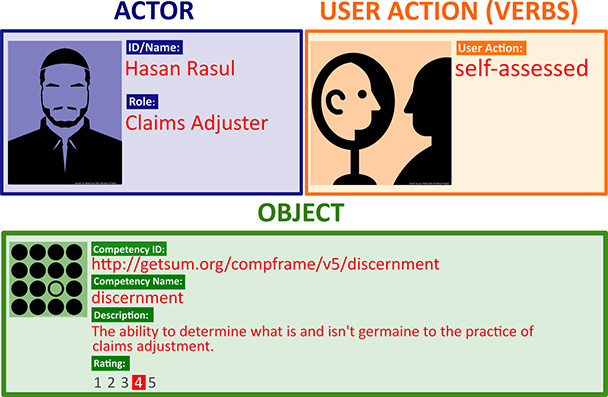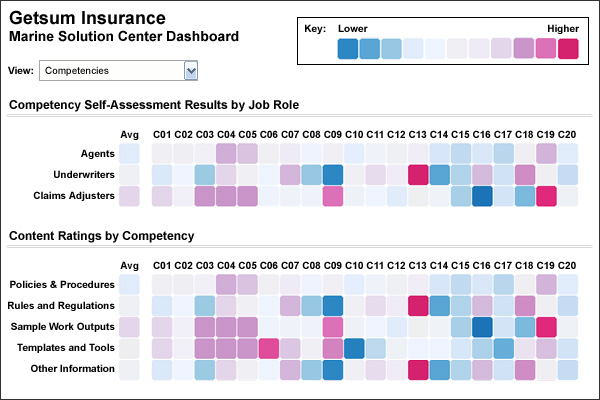How often do you find that the training you are being asked to develop is actually a workaround for broken business processes, missing policies, inadequate standards, or poorly designed systems? These may often be root causes of the human performance problems you are being asked to address with a training solution.
In order to produce effective training, you will probably need to investigate and identify these problems. Ironically, that puts you in a unique position to recommend solutions that may eliminate the need for training, or at least change its focus. However, you may feel that workflow design problems are out of scope. Should your role as an ISD limit your focus to training?
The Experience API (xAPI) can help you address problems for which training alone may not provide a lasting, effective solution: problems where business processes are not working as well as they should. xAPI helps you remove barriers between learning and work, and between training and business process improvement.
Following is a fictitious scenario illustrating a mission-critical business problem. We will explain how you can use xAPI to track workplace performance and use your findings to optimize the design of policies, procedures, and systems that are part of the work environment.
The business challenge
Getsum Insurance has been insuring large businesses for decades. Its growth strategy centers on expansion of its marine policy underwriting. Marine insurance covers land- and ocean-based transport and cargo. The company has built a reputation for speedy marine policy underwriting and claims settlement. This reputation has attracted some very large accounts operating in port cities and inland transportation hubs around the world. Underwriting these policies is complicated, requiring general expertise in marine insurance and specialized knowledge of regulatory requirements in each state, province, and country to be covered by a policy.
Over the next five years, Getsum Insurance anticipates a dramatic loss of highly skilled employees in its Marine Insurance division who are nearing retirement age. At the same time, the company faces stiff industry competition for experienced marine agents and underwriters. The success of its growth strategy depends on the company's ability to develop, retain, and attract marine insurance talent.
Your assignment
A few years ago, Getsum Insurance established a center of excellence called the Marine Solution Center (MSC). The MSC charter is to provide information resources and tools to the marine insurance division to help agents, underwriters, and claims adjusters be successful while maintaining the company's reputation for speed and effectively managing risk.
Senior management has noticed that the MSC has the potential to provide a rich professional support environment and is a valuable asset to help the company attract, develop, and retain marine talent. However, for some reason the MSC has been underutilized. Senior management assumes that people aren't using it simply because they don't know about it. So they've asked L&D to create a mandatory course that must be taken by all marine insurance employees to introduce the MSC, describe its benefits, and promote its use. The L&D director has put you in charge of this important project. The MSC is currently being used far below its capacity, and management assumes that your intervention will increase its utilization and meet the company's goals.
Needs analysis
You begin by taking an MSC content inventory. You find that much of the content is too generalized to provide much value to someone who needs help underwriting a policy or processing a claim.
You interview about a dozen marine employees who have used the MSC recently. The consensus is that the MSC is a good idea, but that it is more useful to people who are new to marine underwriting. Experienced marine practitioners see it as a waste of time and would not recommend the MSC to others.
After conducting a focus group with MSC staff, you find that it is run sort of like a library where they select and organize content by topic. You learn that there are defined competencies for agents, underwriters, and claims adjustors, the three key job roles in the marine division. They have mapped MSC content to these competencies, but no one is sure whether the mapping is effective or useful to marine employees.
Findings and recommendations
Table 1 summarizes your key findings and recommendations.
Table 1: Findings, Recommended Solutions, and Metrics
|
Problem |
Recommended Solution |
Metric(s) |
|
Many MSC searches result in unsuccessful results and high abandonment rates. |
Use search abandonment data to identify content gaps. |
• Number of failed queries • Listing of actual failed queries |
|
While the MSC content is mapped to the competencies that have been defined for Marine Division job roles, it is not clear whether the content is useful. |
Establish a feature to enable MSC users to rate content. Monitor content utilization and ratings to ensure the MSC’s content is relevant and useful. Purge content where access and ratings are low. |
• Number of accesses per content item • Average rating per content item |
|
Currently, there is little or no data to identify organizational competency deficiencies and ensure the MSC is addressing them. |
Implement a mandatory annual competency self-assessment feature in the MSC. Use competency self-assessment results to determine competency deficiencies in the organization and address them with appropriate MSC content. |
• Number of employees who have completed self-assessment • Average self-assessment ratings per competency • List of competencies where average rating is lower than performance standard |
|
Much of the MSC content is informational, but there is little performance-support-oriented content such as tools, templates, rules, regulations, policies, and procedures, or sample work outputs. |
Increase the amount of performance-support-oriented content in the MSC. |
• Number of content type items to content type (per competency) |
Your recommendation: improve the process and measure the impact
Based on the findings of your needs analysis, you explain to the L&D director that creating training to promote the MSC in its current state is not a good idea. Awareness training may get more employees interested in accessing the MSC initially, but based on current use patterns, they are not likely to return. In fact, mandating participation in awareness training may actually create a negative perception of the MSC by getting more people to experience its shortcomings first hand.
Instead, you recommend overhauling the MSC standards, policies, and processes for managing content to ensure MSC offerings are better aligned with its charter and that they address the real needs of marine practitioners. You advocate the use of xAPI to monitor and continually improve the MSC's value, utilization, and business impact.
You can track metrics using xAPI and visualize them in a dashboard. These metrics will enable the organization to continuously monitor how much content is available related to each competency, the balance between higher-level information and more specific performance support content, what content is being used and valued most, whether content adequately covers areas where competency gaps and deficiencies have been identified, and whether users are finding what they are searching for. By monitoring these areas, the organization can take decisive action to continually refine, expand, and improve the MSC’s value to marine division employees.
The L&D director finds your analysis and recommendations to be compelling. She asks you to join her in a presentation to senior management. After the presentation, you have gained the sponsorship and funding needed to implement your recommended solutions.
You will need to develop an xAPI model in order to accomplish the goals of your project. With the right metrics in place, you can easily identify content gaps and deficiencies and work with subject matter experts to address them.
The xAPI solution
You decide to embed xAPI tracking into the MSC web and mobile user interfaces. The first step is to explore the MSC’s content metadata taxonomy. MSC content is tagged by three parameters: content type, job role, and competency. A single content item may be tagged with multiple values for each parameter. There are five possible values for content type: rules and regulations, policies and procedures, sample work outputs, templates and tools, and informational material. There are three job roles: agent, underwriter, and claims adjuster. There are 20 competencies for each job role.
Based on your understanding of the MSC content metadata taxonomy, you create a diagram (Figure 1) to illustrate how xAPI can be applied to generate the metrics listed earlier in Table 1. The diagram contains all three parts of an xAPI activity statement: actor, verb, and object. The actors represent the various types of marine division employees who are MSC users. The verbs describe the actions users perform as they interact with MSC content. The objects represent the various types of content available in the MSC.

Figure 1: The xAPI model
Note that some of the actions users take could be described using the same verb. For example, the word rated refers to MSC users rating of content, but it could also refer to marine division employees rating their own competency in the self-assessment. In our model, we decided to use self-assessed as the verb for people rating their own competencies because we want to distinguish that ratings are about content and self-assessment is about people.
When we create visualizations of the xAPI data, the difference between people rating content and people self-assessing competencies is clearer than it would be if we were to use the verb rated in both contexts. If we were to use the same verb, when we aggregate data for the visualizations we would find ourselves needing to take an extra step to sort all rated statements to separate the data that is about competencies from those about content.
Figure 2 shows an example of an xAPI statement based on this model.

Figure 2: Sample xAPI statement
Preparing for implementation
There are five major steps that you must take to prepare your solution for implementation.
- Develop an online self-assessment that marine division employees are required to take annually to rate themselves against the competencies associated with their job role.
- Change the configuration of the MSC to activate a previously unused system feature that enables users to rate content using a Likert scale.
- Identify the trigger for each xAPI activity statement in the MSC user interface and add the xAPI statements to system’s code.
-
Create a dashboard (Figure 3) using heat maps for MSC administrators to visualize the xAPI tracking results.

Figure 3: xAPI dashboard - The fifth, and perhaps most important step is to define and document a new set of guidelines (Figure 4) and processes for MSC staff to manage content using the usage data in xAPI dashboard.
|
If the dashboard indicates... |
Then take action to... |
|
Self-assessment results have an average rating lower than the standard for the job role. |
Check the amount of content, types of content, content, usage, and content ratings associated with the competency. |
|
Content coverage is low for a competency. |
Add more content. |
|
Content types are not balanced for a competency. |
Add content to balance the content types. |
|
Content is rated poorly. |
Update, retire, or replace the content. |
|
High abandonment rates after searching. |
Identify abandoned search queries where users do not select anything from search results (abandonment) to explore and address potential content gaps. |
Figure 4: New content management guidelines
Conclusion
The xAPI provides a powerful approach to reimagine your ISD role and make changes that go beyond training. In this scenario, you have used the xAPI to effect lasting changes to processes in the business environment including introduction of a new competency self-assessment, MSC system enhancements, content management guidelines and processes, and a data dashboard for monitoring MSC effectiveness. With these business process improvements in place, the MSC is not likely to require this type of overhaul again in the future. You can be confident that by offering more relevant content and better search results, the MSC will continually adapt to the needs of marine division employees. Sometimes being an ISD or a business process engineer is not an either/or proposition. In order to be effective in your job, you must sometimes be both.All Contributors






